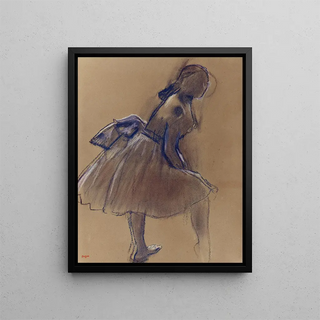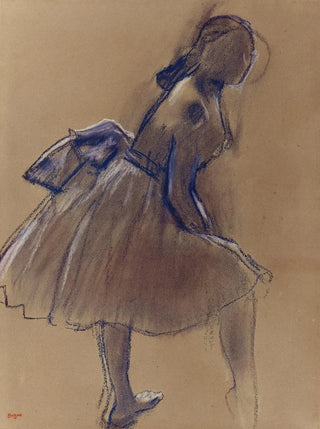Art print of a standing dancer in profile - Edgar Degas | Art print


View from behind

Frame (optional)
In the vibrant world of impressionist art, Edgar Degas's "Reproduction Danseuse debout de profil" stands out for its ability to capture the very essence of movement and the grace of ballerinas. This depiction, imbued with delicacy and dynamism, invites viewers to immerse themselves in a suspended moment, where time seems to pause to reveal the beauty of the gesture. Dance, this quintessential form of artistic expression, is here magnified by Degas's exceptional talent, who manages to immortalize the elegance of the dancers while revealing their humanity. The art print of this iconic work allows for a renewed appreciation of the artist's virtuosity and to absorb the unique atmosphere emanating from his creations.
Style and uniqueness of the work
The "Reproduction Danseuse debout de profil" is characterized by an inimitable style, unique to Degas. The artist employs flowing lines and delicate contours that emphasize the graceful silhouette of the ballerina. The composition, thoughtfully designed, highlights the dancer's posture, capturing a moment of preparation before the performance. The nuances of color, ranging from warm tones to deeper shadows, confer emotional depth to the piece that transcends mere visual appeal. Degas, a true master of movement, plays with light and shadow to bring his creation to life, making every detail palpable. Far from being a simple representation, this work is an ode to the beauty of the body in motion, a celebration of the art of dance that still resonates today.
The artist and his influence
Edgar Degas, born in 1834, is one of the most emblematic figures of the impressionist movement, although he often preferred to distance himself from this label. His work is marked by a passion for ballet and Parisian life, two recurring themes that allowed him to explore the human condition through the lens of beauty and movement. Degas established himself as an innovator, using daring angles and varied techniques, ranging from painting to sculpture. His influence on modern art is

Matte finish

View from behind

Frame (optional)
In the vibrant world of impressionist art, Edgar Degas's "Reproduction Danseuse debout de profil" stands out for its ability to capture the very essence of movement and the grace of ballerinas. This depiction, imbued with delicacy and dynamism, invites viewers to immerse themselves in a suspended moment, where time seems to pause to reveal the beauty of the gesture. Dance, this quintessential form of artistic expression, is here magnified by Degas's exceptional talent, who manages to immortalize the elegance of the dancers while revealing their humanity. The art print of this iconic work allows for a renewed appreciation of the artist's virtuosity and to absorb the unique atmosphere emanating from his creations.
Style and uniqueness of the work
The "Reproduction Danseuse debout de profil" is characterized by an inimitable style, unique to Degas. The artist employs flowing lines and delicate contours that emphasize the graceful silhouette of the ballerina. The composition, thoughtfully designed, highlights the dancer's posture, capturing a moment of preparation before the performance. The nuances of color, ranging from warm tones to deeper shadows, confer emotional depth to the piece that transcends mere visual appeal. Degas, a true master of movement, plays with light and shadow to bring his creation to life, making every detail palpable. Far from being a simple representation, this work is an ode to the beauty of the body in motion, a celebration of the art of dance that still resonates today.
The artist and his influence
Edgar Degas, born in 1834, is one of the most emblematic figures of the impressionist movement, although he often preferred to distance himself from this label. His work is marked by a passion for ballet and Parisian life, two recurring themes that allowed him to explore the human condition through the lens of beauty and movement. Degas established himself as an innovator, using daring angles and varied techniques, ranging from painting to sculpture. His influence on modern art is
12,34 €






